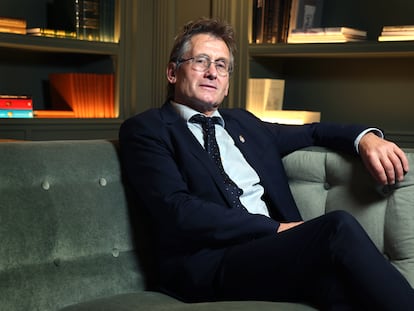Charles Rice, Nobel Prize winner in Medicine: ‘It’s a crime that a drug exists that could cure everyone yet not everybody has access to it’
The virologist, awarded for his part in the discovery of the hepatitis C virus, has helped save the lives of millions of people
This smiling man asking for a glass of water at a hotel bar has helped save the lives of millions of people, according to the Swedish committee that awarded him the Nobel Prize in Medicine. He is American virologist Charles Rice, who won the award five years ago for his role in the discovery of the hepatitis C virus, a pathogen that silently destroys the liver and can develop into a deadly cancer. The virus still infects 50 million people and kills 240,000 every year, despite the fact that the breakthroughs of Rice and other colleagues enabled chemist Michael J. Sofia to discover a cure in 2007, named after him: sofosbuvir. When it became clear that this new drug was miraculous, U.S. pharmaceutical company Gilead bought Sofia’s company, Pharmasset, for $11 billion.
Rice, born in Sacramento 72 years ago, once took “a course on Spanish poetry and magical realism” when he was little more than a teenager. “I was undecided as to what I was going to do with my life,” he recalls. He worked odd jobs to earn a bit of money: tomato inspector at a ketchup factory, belt guard at a peach canning plant, janitor at a club where he cleaned filthy toilets after parties. “I’m pretty good at it, I’m relatively quick, and I leave a lingering shine,” he jokes. After earning his degree in Zoology, he and some friends bought a second-hand Volkswagen van and set off on a long journey through the Americas, “heading south with no destination in mind.” Months later, he reached Argentina.
By the time he had become a virologist at Washington University in St. Louis, Rice faced a challenge. Scientists Harvey Alter and Michael Houghton had discovered an unknown virus in people who developed hepatitis after receiving donated blood transfusions. In 1997, Rice and other colleagues demonstrated that this virus was the cause of the disease. “The finding was an important step in developing blood tests and new medications that have saved millions of lives,” explains the statement from the Nobel Prize. Passing through the Spanish city of Valencia as part of the jury for the Rei Jaume I Awards, Rice becomes serious when speaking about the cost of the drugs that are capable of curing the disease.
Question. When you won the Nobel Prize, Dr. Graciela Diap, from the Drugs for Neglected Diseases Initiative, celebrated the fact that thanks to the award-winning work, drugs existed to cure hepatitis C, but added: “In Latin America, out of the four million people living with hepatitis C, only 1% receive treatment. […] How can we explain this spectacular failure?”
Answer: We’re still in that era, but it varies quite a bit on the country. Initially, part of the problem was the price companies were charging. When sofosbuvir came out about 10 years ago, it cost $84,000 per person, which is a lot of money, but the company argued that it cost a lot to develop the drug. Gilead basically bought this compound from a biotech company called Pharmasset. They paid $11 billion and then had to do a Phase 3 trial [an experiment with hundreds of people to show the drug was safe and effective]. So they spent a lot of money. The question is: How do they price the drug to recoup their costs and make a profit? I don’t know how they do it, but I found the price dismaying: $84,000, considering the actual cost of manufacturing the drug?
Q. That was about $80.
A. Yes, the manufacturing cost was $100 or $200. This amount doesn’t take into account the $11 billion and subsequent clinical development costs, but one would expect a price closer to the manufacturing cost. It’s a crime that a drug exists that could cure everyone and yet not everybody has access to it due to its price, among other reasons. The price has been negotiated down in some countries. In Egypt, for example, they had a terrible hepatitis C problem, with 10% of the population infected with the virus. They reached an agreement with the company to manufacture the drug in Egypt and sell it at a price that the public health system could afford. It’s been one of the most successful programs. And I think it’s similar in Spain; they’ve managed to cure 90% of the infected population. This drug is already being provided at very low prices in other African countries, but it’s a painfully slow process. We live in a world where making money is largely the motivating force behind people’s actions. And that’s a problem, because drugs for some diseases aren’t developed because there’s not enough money to be made from them.
Q. Some $61 million of public money was invested in the development of sofosbuvir, according to a Harvard University study. Are taxpayers paying twice for the same drug?
A. That amount would hardly be enough. What taxpayers paid for was research like ours, which allowed us to do the preclinical work and determine that this compound had those properties, but that’s only a tiny sliver, albeit extremely important, part of what it actually cost to develop this drug. Gilead paid $11 billion to buy it from Pharmasset.
Q. But that amount may be speculation.
A. It’s speculation. And, of course, they made money, but you can’t say we paid $61 million for the drug and that’s all it’s worth.
Q. Humanity has only managed to eradicate one human disease from the planet: smallpox. Could hepatitis C be the second?
A. I would have hoped. Great work is being done in Spain, but in the United States, we’re not doing so well: the incidence of hepatitis C is going up, not down. The opioid epidemic is giving rise to more infections. It’s disappointing. We have drugs that could eradicate the virus, but things are not so simple. Francis Collins, who was director of the National Institutes of Health for many years, got behind the effort to eradicate hepatitis C in the United States by 2030. The Biden administration allocated about $10 billion to achieve this. With the new administration [of Donald Trump], this is all gone.
A. Yes, science is under attack. We’re close to eradicating some diseases, but they’re reappearing and spreading again because of the anti-science and anti-vaccine movement.
Q. Is U.S. Health Secretary Robert F. Kennedy an anti-vaxxer?
A. Yes, it’s unbelievable. Now they’re saying that the RNA vaccine against COVID-19, which was a historic discovery, is awful. We have people in positions of power in the United States who are not the people who should be making these decisions.
Q. That’s crazy.
A. It’s crazy, it really is. I don’t know where it’s going to end. It seems like every day something else has been torn down. Medical research and science blossomed in the United States after World War II. It took more than 70 years to get to the point that it’s at, and in a matter of months, it’s being torn to shreds.
Q. Donald Trump intends to cut the budget of the National Institutes of Health by 40%.
A. It’s a pretty grim time for medical research. There’s a quote I like from Mary Lasker, who was a great supporter of the concept of the National Institutes of Health many decades ago: “If you think research is expensive, try disease.” Preventing disease is a lot cheaper than letting it happen and then trying to respond. Our ability to respond to the next pandemic is far worse than our response to COVID-19, which was far from as good as we could do. It’s terrible. After the COVID-19 experience, I thought we’d finally have a new golden age for infectious disease research, but that spirit lasted a couple of years, and then basically all those programs that were in place were stopped.
Tu suscripción se está usando en otro dispositivo
¿Quieres añadir otro usuario a tu suscripción?
Si continúas leyendo en este dispositivo, no se podrá leer en el otro.
FlechaTu suscripción se está usando en otro dispositivo y solo puedes acceder a EL PAÍS desde un dispositivo a la vez.
Si quieres compartir tu cuenta, cambia tu suscripción a la modalidad Premium, así podrás añadir otro usuario. Cada uno accederá con su propia cuenta de email, lo que os permitirá personalizar vuestra experiencia en EL PAÍS.
¿Tienes una suscripción de empresa? Accede aquí para contratar más cuentas.
En el caso de no saber quién está usando tu cuenta, te recomendamos cambiar tu contraseña aquí.
Si decides continuar compartiendo tu cuenta, este mensaje se mostrará en tu dispositivo y en el de la otra persona que está usando tu cuenta de forma indefinida, afectando a tu experiencia de lectura. Puedes consultar aquí los términos y condiciones de la suscripción digital.
More information
Archived In
Últimas noticias
There is as much life left to discover on planet Earth as that which is already known
Dozens presumed dead, around 100 injured in fire at Swiss Alps bar during New Year’s celebration
Is porn for women different from conventional porn? We spoke to those who make it
Cartagena de Indias is sinking: What can the city do to mitigate it?
Most viewed
- Reinhard Genzel, Nobel laureate in physics: ‘One-minute videos will never give you the truth’
- Sinaloa Cartel war is taking its toll on Los Chapitos
- David King, chemist: ‘There are scientists studying how to cool the planet; nobody should stop these experiments from happening’
- Oona Chaplin: ‘I told James Cameron that I was living in a treehouse and starting a permaculture project with a friend’
- The Interoceanic Train, the Mexican alternative to the Panama Canal










































